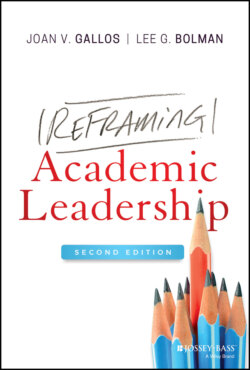Читать книгу Reframing Academic Leadership - Lee G. Bolman - Страница 17
Successful academic leaders …
Оглавление1 Create campus policies, arrangements, and reporting relationships that offer clarity, coordinate the efforts of multiple people and units, and facilitate productivity for all.
2 Create caring and productive campus environments that channel talent and encourage cooperation.
3 Respect differences, manage them productively, and respond ethically and responsibly to the needs of multiple constituencies.
4 Infuse everyday efforts with energy and soul.
The family image focuses on the powerful symbiotic relationship between people and organizations: individuals need opportunities to express their talents and skills; organizations need human energy and contribution to fuel their efforts. When the fit is right, both benefit. Effective academic leaders create caring and productive campus environments where all find ways to work cooperatively and to channel their full talents to the mission.
The jungle image encapsulates a world of enduring differences: diverse species or tribes participating in a complex dance of cooperation and competition as they maneuver for influence and scarce resources. Diversity of values, beliefs, interests, behaviors, skills, goals, and worldviews often spawns destructive campus conflicts. But diversity is also the wellspring of creativity and innovation – and hope for the future of higher education. Skilled academic administrators are compassionate politicians who anticipate and respect differences, manage them productively, and respond to the needs of multiple constituencies without losing sight of institutional goals and priorities.
Finally, the theater image captures university life as an ongoing drama: individuals coming together to create context, culture, commitment, and meaning as they play their assigned roles and bring artistry and self‐expression into their work. Good theater fuels the moral imagination, and successful campus leaders infuse everyday efforts with energy and soul.
Multi‐frame thinking is necessary because colleges and universities are messy and difficult organizations that require from their leaders simultaneous attention to vastly different sets of needs. Academic institutions need a solid organizational architecture that effectively channels information, resources, and human talents to support institutional goals. At the same time, they need workplace relationships and a campus environment that motivate and foster high levels of satisfaction and productivity. Innovation comes from managing the enduring differences at the center of university life that can spark misunderstandings, disagreements, and power struggles. Finally, every institution needs a culture that aligns with its values, inspires individual and collective efforts, and provides the symbolic glue to coordinate diverse constituents and contributions. The continuing success of institutions like Harvard and Stanford rests as much on their culture as on their money and talent. In such a complex institutional world, multi‐frame thinking keeps university administrators alert and responsive to the demands of the whole while avoiding a narrow optic. Oversimplified views of reality cause academic leaders to stumble down the wrong path, squandering resources, time, and credibility along the way.
Strong academic leaders are skilled in the art of reframing – a deliberate process of shifting perspectives to see the same situation in multiple ways and through different lenses. Experience, training, and developmental limitations leave many leaders with a limited palette of perspectives for making sense of their work. The dearth of training and pre‐service preparation for college and university leaders exacerbates this barrier. As a result, academic leaders can get stuck in their comfort zones – shielded from experiences that challenge them to see beyond their current preferences (Gallos, 2005). When things turn out badly, they blame circumstances, the environment, a lack of resources, or other people, unaware that limits in their own thinking have restricted their options and undermined their efforts. More versatile habits of mind enable academic leaders to think in more comprehensive ways about their own leadership and about the complexities and opportunities in leading colleges and universities (Aziz et al., 2004; Debowski & Blake, 2004).
Above all, our goal is to encourage optimism, confidence, and clarity of purpose. Academic leadership is a noble enterprise, albeit a challenging one – made even more complex by a pandemic that turned the world upside‐down overnight and raised deep questions about what we need and do and about where and how we work. We may never fully escape human error and imperfection, but we can always do better – and we need to. Educating students, creating knowledge, facilitating life‐saving research, and serving society demand all the intellect, skill, and commitment that academic leaders can muster. Our hope is that this book provides opportunities to expand your thinking, strengthen your resolve, clarify your purpose, and deepen your commitment and capacity to achieve your full potential as an academic leader.
